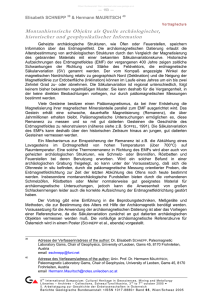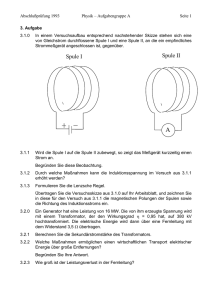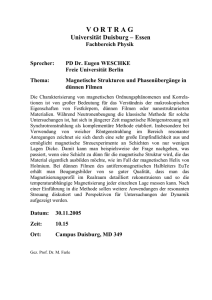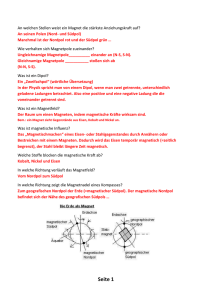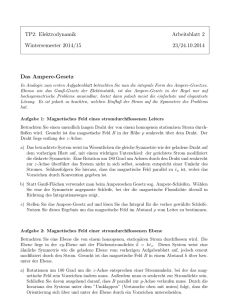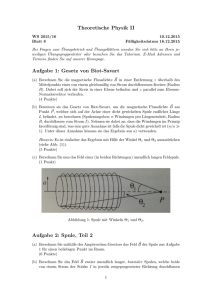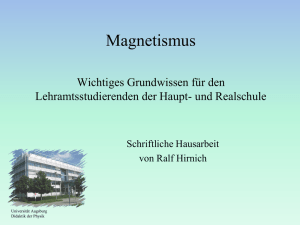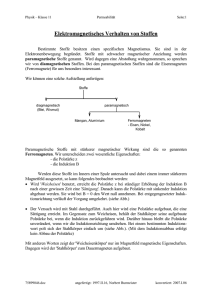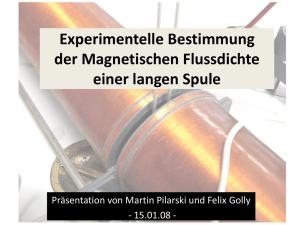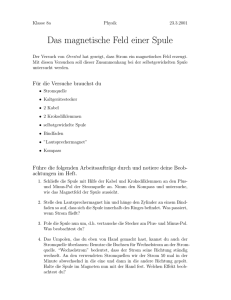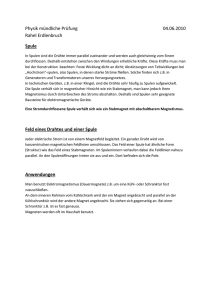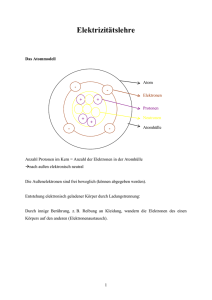C Magnetostatik Magnetostatics
Werbung
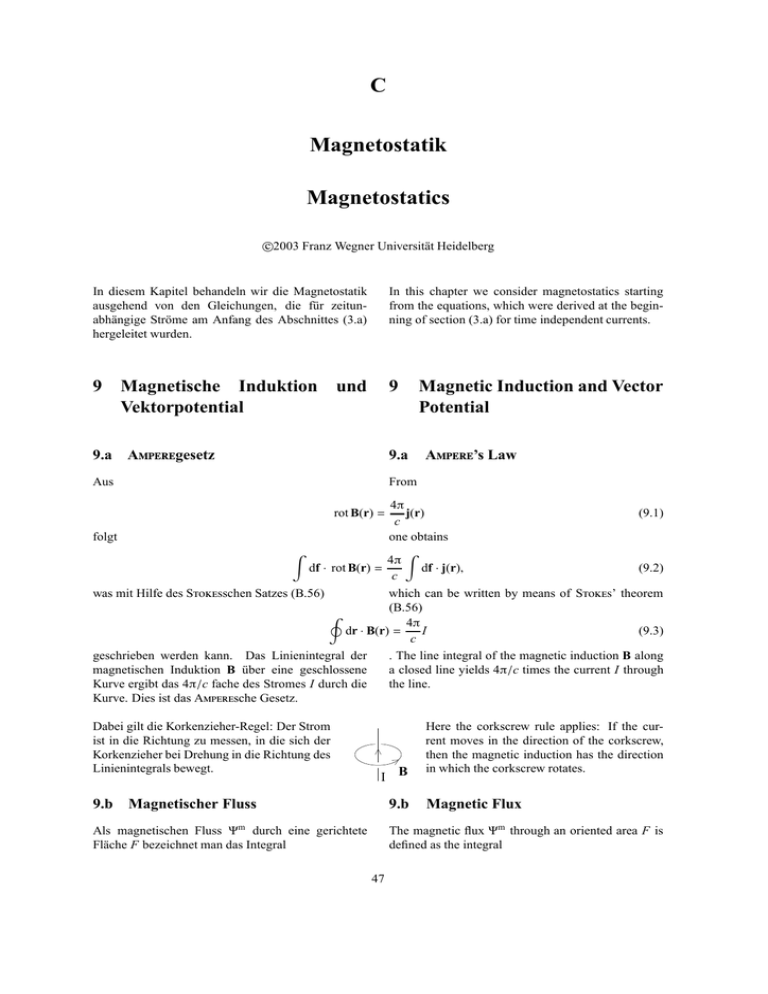
C Magnetostatik Magnetostatics c 2003 Franz Wegner Universität Heidelberg In diesem Kapitel behandeln wir die Magnetostatik ausgehend von den Gleichungen, die für zeitunabhängige Ströme am Anfang des Abschnittes (3.a) hergeleitet wurden. In this chapter we consider magnetostatics starting from the equations, which were derived at the beginning of section (3.a) for time independent currents. 9 Magnetische Induktion Vektorpotential 9 und 9.a Agesetz 9.a Aus From Magnetic Induction and Vector Potential A’s Law 4π j(r) (9.1) c folgt one obtains Z Z 4π df · j(r), (9.2) df · rot B(r) = c was mit Hilfe des Sschen Satzes (B.56) which can be written by means of S’ theorem (B.56) I 4π dr · B(r) = I (9.3) c geschrieben werden kann. Das Linienintegral der . The line integral of the magnetic induction B along magnetischen Induktion B über eine geschlossene a closed line yields 4π/c times the current I through Kurve ergibt das 4π/c fache des Stromes I durch die the line. Kurve. Dies ist das Asche Gesetz. rot B(r) = Dabei gilt die Korkenzieher-Regel: Der Strom ist in die Richtung zu messen, in die sich der Korkenzieher bei Drehung in die Richtung des Linienintegrals bewegt. 9.b I B Magnetischer Fluss 9.b Als magnetischen Fluss Ψm durch eine gerichtete Fläche F bezeichnet man das Integral Here the corkscrew rule applies: If the current moves in the direction of the corkscrew, then the magnetic induction has the direction in which the corkscrew rotates. Magnetic Flux The magnetic flux Ψm through an oriented area F is defined as the integral 47 48 C Magnetostatik C Magnetostatics Ψm = Z df · B(r). (9.4) F Der magnetische Fluss hängt nur von der Berandung The magnetic flux depends only on the boundary ∂F ∂F der Fläche ab. Zum Beweis bilden wir die Difof the area. To show this we consider the difference ferenz des Flusses durch zwei Flächen F 1 und F2 mit of the flux through two areas F 1 and F2 with the same der gleichen Berandung und erhalten boundary and obtain Z Z Z Z m Ψm − Ψ = df · B(r) − df · B(r) = df · B(r) = d3 r div B(r) = 0 (9.5) 1 2 F1 F2 F V mit Hilfe des Gßschen Satzes (B.59) und div B(r) = 0. by means of the divergence theorem (B.59) and div B(r) = 0. Dabei seien F 1 und F2 in die gleiche Richtung (zum Beispiel nach oben) orientiert. Die geschlossene Fläche F setzt sich aus F1 und F2 zusammen, wobei F 2 jetzt in der umgekehrten Richtung orientiert sei. Dann hat F eine bestimmte Orientierung (zum Beispiel nach außen) und schließt das Volumen V ein. Suppose F1 and F2 are oriented in the same direction (for example upwards). Then the closed surface F is composed of F 1 and F2 , where F2 is now oriented in the opposite F2 direction. Then F has a definite orientation (for example outwards) and includes the volume V. 9.c Feld einer Stromverteilung 9.c Aus rot rot B(r) = (4π/c) rot j(r) folgt wegen (B.26) From curl curl B(r) = (4π/c) curl j(r) due to (B.26) F1 Field of a Current Distribution rot rot B(r) = grad div B(r) − 4B(r) und div B(r) = 0 (9.6) and div B(r) = 0 one obtains 4B(r) = − mit der Lösung 4π rot j(r) c with the solution (9.7) Z Z Z 1 1 1 1 1 r0 − r 0 0 0 3 0 0 rot j(r ) = − × j(r ) = d3 r 0 d r ∇ d3 r 0 × j(r0 ), (9.8) 0 0 c |r − r | c |r − r | c |r − r0 |3 wobei wir beim zweiten Gleichheitszeichen (B.63) where we have used (B.63) at the second equals sign. verwendet haben. Der letzte Ausdruck wird als das The last expression is called the law of B and Gesetz von B und S bezeichnet. S. B(r) = Ist die Ausdehnung eines Drahtes senkrecht zur Stromrichtung vernachlässigbar klein (Stromfaden), so kann man d3 r0 j(r0 ) = d f 0 dl0 j(r0 )e = Idr0 approximieren und erhält e B(r) = Als Beispiel betrachten wir die Induktion in der Mittelachse eines Kreisstromes dl df I c Z r0 − r × dr0 |r − r0 |3 (9.9) As an example we consider the induction in the middle axis of a current along a circle z y φ If the extension of a wire perpendicular to the direction of the current is negligible (filamentary wire) then one can approximate d3 r0 j(r0 ) = d f 0 dl0 j(r0 )e = Idr0 and obtains x 9 Magnetische Induktion und Vektorpotential r = zez , 9 Magnetic Induction and Vector Potential r0 = (R cos φ, R sin φ, z0 ) dr0 = (−R sin φ, R cos φ, 0)dφ (r0 − r) × dr0 = (R(z − z0 ) cos φ, R(z − z0 ) sin φ, R2 )dφ 2πIR2 ez . B(0, 0, z) = c(R2 + (z − z0 )2 )3/2 49 (9.10) (9.11) (9.12) Davon ausgehend berechnen wir das Feld in der MitStarting from this result we calculate the field in the telachse einer Spule. Sie habe N Windungen und reiaxis of a coil. The number of windings be N and it che von z0 = −l/2 bis z0 = +l/2. Wir erhalten dann extends from z0 = −l/2 to z0 = +l/2. Then we obtain Z +l/2 l l − z + z Ndz0 2πIR2 ez 2πIN 2 2 . (9.13) B(0, 0, z) = + q = ez q 2 0 2 3/2 l c(R + (z − z ) ) cl R2 + ( l − z)2 −l/2 2 + ( l + z)2 R 2 2 If the coil is long, R l, then one may neglect R2 and obtains inside the coil Ist die Spule lang, R l, dann kann man für hinreichend große Entfernung vom Spulenende das R2 im Nenner vernachlässigen und erhält für das Innere der Spule B= An den Spulenenden ist das Feld auf die Hälfte des Wertes im Inneren abgefallen. Aus dem Aschen Gesetz folgt bei Integration längs des in der Figur angegebenen Weges 4πIN ez . cl (9.14) At the ends of the coil the field has decayed to one half of its intensity inside the coil. From A’s law one obtains by integration along the path described in the figure l R I Daher gilt im Innern näherungsweise der in (9.14) bestimmte Wert, während außerhalb die magnetische Induktion klein dagegen ist. 4π IN. (9.15) c Thus inside the coil one obtains the induction (9.14), whereas the magnetic induction outside is comparatively small. 9.d 9.d Vektorpotential dr · B = Vector Potential Wir formen den Ausdruck für die magnetische IndukWe now rewrite the expression for the magnetic tion um induction Z Z 1 1 1 1 3 0 0 0 dr ∇ d3 r 0 ∇ B(r) = − × j(r ) = × j(r0 ) = rot A(r) (9.16) 0 c |r − r | c |r − r0 | mit with Z 1 j(r0 ) . (9.17) d3 r 0 A(r) = c |r − r0 | Man bezeichnet A als das Vektorpotential. Man One calls A the vector potential. Consider the analog betrachte den analogen Zusammenhang zwischen relation between charge density ρ and the electric poLadungsdichte ρ und dem elektrischen Potential Φ in tential φ in electrostatics (3.14). We show that A is der Elektrostatik (3.14). Wir zeigen noch, dass A didivergence-free vergenzfrei ist ! ! Z Z 1 1 1 1 0 3 0 0 3 0 div A(r) = dr ∇ · j(r ) = − dr ∇ · j(r0 ) c |r − r0 | c |r − r0 | 50 C Magnetostatik C Magnetostatics = 1 c Z d3 r 0 1 ∇0 j(r0 ) = 0. |r − r0 | (9.18) Bei dem dritten Gleichheitszeichen haben wir partiell integriert (B.62). Am Schluss haben wir div j(r) = 0 verwendet. At the third equals sign we have performed a partial integration (B.62). Finally we have used div j(r) = 0. 9.e Kraft zwischen zwei Stromkreisen 9.e Wir betrachten noch die Kraft zwischen zwei Stromkreisen. Die Kraft, die der Stromkreis (1) auf den Stromkreis (2) ausübt, ist Finally, we consider the force between two circuits. The force exerted by circuit (1) on circuit (2) is K2 = = Force Between Two Circuits ! Z Z 1 1 1 0 × j (r ) d3 rj2 (r) × B1 (r) = 2 d3 rd3 r0 j2 (r) × ∇ 1 c |r − r0 | c Z Z 1 1 1 1 3 3 0 0 3 3 0 d rd r j (r ) · j (r) ∇ d rd r ∇ − · j (r) j1 (r0 ) 1 2 2 c2 |r − r0 | c2 |r − r0 | (9.19) unter Verwendung von (B.14). Da wegen (B.62) where (B.14) has been applied. Since due to (B.62) Z Z 1 1 d3 r ∇ · j (r) = − d3 r ∇ · j2 (r) (9.20) 2 |r − r0 | |r − r0 | und div j2 (r) = 0, folgt schließlich für die Kraft and div j2 (r) = 0, one obtains finally for the force Z 1 1 . (9.21) d3 rd3 r0 j1 (r0 ) · j2 (r) ∇ K2 = 2 |r − r0 | c Die auf den ersten Stromkreis wirkende Kraft erhält man durch Austauschen von 1 und 2. Gleichzeitig kann man r und r0 austauschen. Man sieht dann, dass The force acting on circuit (1) is obtained by exchanging 1 and 2. Simultaneously, one can exchange r and r0 . One sees then that K1 = −K2 (9.22) gilt. holds. Aufgabe Berechne die Kraft zwischen zwei von Strömen I1 und I2 durchlaufenen Drähten, die über die Länge l parallel im Abstand r (r l) laufen. Hieraus bestimmten K und W die Lichtgeschwindigkeit. Exercise Calculate the force between two wires of length l carrying currents I1 and I2 which run parallel in a distance r (r l). K and W measured this force in order to determine the velocity of light. 10 Ringströme als magnetische Dipole 10 Loops of Current as Magnetic Dipoles 51 10 Ringströme als magnetische Dipole 10 Loops of Current as Magnetic Dipoles 10.a Lokalisierte Stromverteilung und magnetischer Dipol 10.a Localized Current Distribution and Magnetic Dipole Wir betrachten eine Stromverteilung, die außerhalb We consider a distribution of currents which vanishes einer Kugel vom Radius R verschwindet (j(r0 ) = 0 für outside a sphere of radius R (j(r0 ) = 0 for r0 > R) and 0 r > R) und fragen nach der magnetischen Induktion determine the magnetic induction B(r) for r > R. We B(r) für r > R. Wir können dann das Vektorpotential may expand the vector potential A(r) (9.17) similar to A(r) (9.17) ähnlich wie das elektrische Potential Φ(r) the electric potential Φ(r) in section (4) in Abschnitt (4) entwickeln Z Z Z 0 1 1 xα 3 0 j(r ) 3 0 0 A(r) = = d3 r0 x0α j(r0 ) + ... (10.1) dr d r j(r ) + 3 c |r − r0 | cr cr Da durch die Kugeloberfläche kein Strom fließt, folgt Since no current flows through the surface of the sphere one obtains Z Z Z Z 3 3 0= df · g(r)j(r) = d r div (g(r)j(r)) = d r grad g(r) · j(r) + d3 rg(r) div j(r), (10.2) wobei die Integrale über die Oberfläche beziehungswhere the integrals are extended over the surface and weise das Volumen der Kugel erstreckt werden. Aus the volume of the sphere, respectively. From the equader Kontinuitätsgleichung (1.12,3.1) folgt also tion of continuity (1.12,3.1) it follows that Z d3 r grad g(r) · j(r) = 0. (10.3) Dies verwenden wir, um die Integrale in der EntThis is used to simplify the integral in the expansion wicklung (10.1) zu vereinfachen. Mit g(r) = xα folgt (10.1). With g(r) = xα one obtains Z d3 r jα (r) = 0. (10.4) Damit fällt der erste Term der Entwicklung weg. Es Thus the first term in the expansion vanishes. There gibt keinen mit 1/r abfallenden Beitrag im Vektorpois no contribution to the vector potential decaying tential für die Magnetostatik, das heißt keinen maglike 1/r in magnetostatics, i.e. there is no magnetic netischen Monopol. Mit g(r) = xα xβ folgt monopole. With g(r) = xα xβ one obtains Z d3 r xα jβ (r) + xβ jα (r) = 0. (10.5) Damit können wir umformen Thus we can rewrite Z Z Z 1 1 d3 r(xα jβ − xβ jα ) + d3 r(xα jβ + xβ jα ). d3 rxα jβ = 2 2 (10.6) Das zweite Integral verschwindet, wie wir gerade The second integral vanishes, as we have seen. The gesehen haben. Das erste ändert sein Vorzeichen bei first one changes its sign upon exchanging the indices Austausch der Indices α und β. Man führt ein α and β. One introduces Z Z 1 d3 r(xα jβ − xβ jα ) = cα,β,γ mγ (10.7) d3 rxα jβ = 2 und bezeichnet den sich daraus ergebenden Vektor m= 1 2c and calls the resulting vector Z d3 r0 (r0 × j(r0 )) (10.8) 52 C Magnetostatik C Magnetostatics als das magnetische Dipolmoment. Damit folgt dann magnetic dipole moment.. Then one obtains xα cα,β,γ mγ + ... cr3 m×r + ... r3 Aβ (r) = A(r) = Mit B(r) = rot A(r) folgt (10.9) (10.10) with B(r) = curl A(r) one obtains 3r(m · r) − mr2 + ... (10.11) r5 Dies ist das Feld eines magnetischen Dipols. Es hat This is the field of a magnetic dipole. It has the same die gleiche Form wie das elektrische Feld des elekform as the electric field of an electric dipole (4.12) trischen Dipols (4.12) p · r 3r(p · r) − pr2 E(r) = − grad 3 = , (10.12) r r5 B(r) = aber es besteht ein Unterschied am Ort des Dipols. Anschaulich entnimmt man das der nebenstehenden Figur. Man berechne den δ3 (r)-Beitrag zu den beiden Dipolmomenten. Vergleiche (B.71). B E 10.b Magnetisches Dipolmoment eines Ringstroms 10.b but there is a difference at the location of the dipole. This can be seen in the accompanying figure. Calculate the δ3 (r)-contribution to both dipolar moments. Compare (B.71). Magnetic Dipolar Moment of a Current Loop Für das Dipolmoment eines Stromes auf einer The magnetic dipolar moment of a current on a closed geschlossenen Kurve erhält man curve yields Z I I m= (10.13) r × dr = f, 2c c zum Beispiel e.g. mz = I 2c Z (xdy − ydx) = (10.14) dr Here fα is the projection of the area inside the loop onto the plane spanned by the two other axes 1 r × dr. 2 (10.15) Dabei ist fα die Projektion der vom Leiter eingeschlossenen Fläche auf die von den beiden anderen Achsen aufgespannte Ebene r df = I fz . c P P Falls j = i qi vi δ3 (r − ri ), dann folgt für das magne- If j = i qi vi δ3 (r − ri ), then using (10.8) the magnetic tische Moment aus (10.8) moment reads X X qi 1 m= q i ri × v i = li , (10.16) 2c i 2mi c i wobei mi für die Masse und li für den Drehimpuls steht. Haben wir es mit einer Sorte Ladungsträger zu tun, dann gilt m= where mi is the mass and li the angular momentum. If only one kind of charges is dealt with, then one has q l. 2mc (10.17) 10 Ringströme als magnetische Dipole Dies gilt für Orbitalströme. dagegen 10 Loops of Current as Magnetic Dipoles Für Spins hat man m= wobei s der Drehimpuls des Spins ist. Für Elektronen ist der gyromagnetische Faktor g = 2.0023 und die Komponenten des Spins s nehmen die Werte ±~/2 an. Da der Bahndrehimpuls quantenmechanisch ganzzahlige Vielfache von ~ annimmt, führt man als Einheit des magnetischen Moments des Eleke0 ~ trons das Bsche Magneton ein, µ B = 2m = 0c 1/2 −20 2 0.927 · 10 dyn cm . 53 This applies for orbital currents. For spins, however, one has q gs, (10.18) 2mc where s is the angular momentum of the spin. The gyromagnetic factor for electrons is g = 2.0023 and the components of the spin s are ±~/2. Since in quantum mechanics the orbital angular momentum assumes integer multiples of ~, one introduces as unit for the magnetic moment of the electron B’s magneton, e0 ~ µB = 2m = 0.927 · 10−20 dyn1/2 cm2 . 0c 10.c Kraft und Drehmoment auf einen Dipol im äußeren magnetischen Feld 10.c 10.c.α Kraft 10.c.α Force and Torque on a Dipole in an External Magnetic Field Force Eine äußere magnetische Induktion Ba übt auf einen An external magnetic induction Ba exerts on a loop of Ringstrom die L-Kraft a current the L force Z Z Z 1 1 ∂Ba ∂Ba 1 d3 rj(r) × Ba (r) = − Ba (0) × d3 rj(r) − × d3 rxα jβ (r)eβ − ... = − × eβ α,β,γ mγ (10.19) K= c c c ∂xα ∂xα aus. Wir formen mγ α,β,γ eβ = mγ eγ × eα = m × eα um . We rewrite mγ α,β,γ eβ = mγ eγ × eα = m × eα and find und finden ∂Ba ∂Ba ∂Ba K=− × (m × eα ) = (m · )eα − (eα · )m. (10.20) ∂xα ∂xα ∂xα The last term vanishes because of div B = 0. The Der letzte Term verschwindet wegen div B = 0. Für first term on the right hand side can be written (m · den ersten Term der rechten Seite erhalten wir (m · ∂Ba,γ ∂Ba,α ∂Ba,γ ∂Ba,α ∂Ba ∂Ba ∂xα )eα = mγ ∂xα eα = mγ ∂xγ eα = (m∇)Ba , wobei ∂xα )eα = mγ ∂xα eα = mγ ∂xγ eα = (m∇)Ba , where wir rot Ba = 0 in der Gegend des Dipols verwendet we have used curl Ba = 0 in the region of the dipole. haben. Daher bleibt Thus we obtain the force K = (m grad )Ba (10.21) als Kraft auf den magnetischen Dipol ausgedrückt durch den Vektorgradienten (B.18). Dies ist in Analogie zu (4.35), wo wir als Kraft auf den elektrischen Dipol (p grad )Ea erhielten. acting on the magnetic dipole expressed by the vector gradient (B.18). This is in analogy to (4.35), where we obtained the force (p grad )Ea acting on an electric dipole. 10.c.β Drehmoment 10.c.β Torque Das mechanische Drehmoment auf den magnetiThe torque on a magnetic dipole is given by schen Dipol ergibt sich zu Z Z Z 1 1 1 d3 rr × (j × Ba ) = − Ba d3 r(r · j) + d3 r(Ba · r)j. (10.22) Mmech = c c c Das erste Integral verschwindet, was man mit (10.3) The first integral vanishes, which is easily seen from und g = r2 /2 leicht sieht. Das zweite Integral ergibt (10.3) and g = r 2 /2. The second integral yields Z 1 Mmech = eβ Ba,α d3 rxα jβ = Ba,α eβ α,β,γ mγ = m × Ba (10.23) c Analog war das Drehmoment auf einen elektrischen Analogously the torque on an electric dipole was p × Dipol p × Ea , (4.36). Ea , (4.36). 54 C Magnetostatik C Magnetostatics Aus dem Kraftgesetz schließt man auf die Energie eines magnetischen Dipols im äußeren Feldes zu From the law of force one concludes the energy of a magnetic dipole in an external field as U = −m · Ba . Das ist korrekt für permanente magnetische Dipole. Aber das genaue Zustandekommen dieses Ausdrucks wird erst bei Behandlung des Induktionsgesetzes klar (Abschnitt 13). (10.24) This is correct for permanent magnetic moments. However, the precise derivation of this expression becomes clear only when we treat the law of induction (section 13). 11 Magnetismus in Materie. Feld einer Spule 11 Magnetism in Matter. Field of a Coil 55 11 Magnetismus in Materie. Feld einer Spule 11 Magnetism in Matter. Field of a Coil 11.a Magnetismus in Materie 11.a Ähnlich wie wir die Polarisationsladungen in der Elektrostatik von den freibeweglichen Ladungen separiert haben, zerlegen wir die Stromdichte in eine freibewegliche Ladungsstromdichte jf und in die Magnetisierungsstromdichte jM , die etwa von Orbitalströmen der Elektronen herrührt In a similar way as we separated the polarization charges from freely accessible charges, we divide the current density into a freely moving current density jf and the density of the magnetization current jM , which may come from orbital currents of electrons Magnetism in Matter j(r) = jf (r) + jM (r). (11.1) Wir führen dazu die Magnetisierung als magnetische Dipoldichte ein We introduce the magnetization as the density of magnetic dipoles P mi (11.2) M= ∆V und führen wieder den Grenzübergang zum Kontinand conduct the continuum limit uum durch Z X mi f (ri ) → d3 r0 M(r0 ) f (r0 ). (11.3) i Dann erhalten wir für das Vektorpotential unter VerThen using (10.10) we obtain for the vector potential wendung von (10.10) Z Z 1 M(r0 ) × (r − r0 ) jf (r0 ) A(r) = + d3 r 0 . (11.4) d3 r 0 0 c |r − r | |r − r0 |3 Das zweite Integral lässt sich umformen in Z d3 r0 M(r0 ) × ∇0 The second integral can be rewritten Z 1 1 = d3 r 0 ∇0 × M(r0 ), |r − r0 | |r − r0 | so dass man (11.5) so that one obtains A(r) = 1 c Z d3 r 0 1 (jf (r0 ) + c rot 0 M(r0 )) |r − r0 | erhält. Es liegt nahe, (11.6) . Thus one interprets jM (r0 ) = c rot 0 M(r0 ) (11.7) als Magnetisierungsstromdichte zu interpretieren. as the density of the magnetization current. Then one Damit folgt dann für die magnetische Induktion obtains for the magnetic induction 4π rot B(r) = jf (r) + 4π rot M(r). (11.8) c Man führt nun die magnetische Feldstärke Now one introduces the magnetic field strength H(r) := B(r) − 4πM(r) ein, für die dann die Mgleichung (11.9) for which M’s equation rot H(r) = 4π jf (r) c (11.10) 56 C Magnetostatik C Magnetostatics gilt. An der anderen Mgleichung div B(r) = 0 ändert sich dadurch nichts. holds. M’s equation div B(r) = 0 remains unchanged. Für para- und diamagnetische Substanzen ist für nicht zu große Feldstärken One obtains for paramagnetic and diamagnetic materials in not too strong fields M = χm H, B = µH, µ = 1 + 4πχm , (11.11) wobei χm als magnetische Suszeptibilität und µ als relative Permeabilität bezeichnet werden. Im Supraleiter erster Art ist B = 0 (vollständiger Diamagnetismus). Die magnetische Induktion wird dort durch Oberflächenströme vollständig aus dem Material verdrängt. where χm is the magnetic susceptibility and µ the permeability. In superconductors (of first kind) one finds complete diamagnetism B = 0. There the magnetic induction is completely expelled from the interior by surface currents. Als Randbedingungen folgt analog zur Argumentation für die dielektrische Verschiebung und die elektrische Feldstärke die Stetigkeit der Normalkomponente Bn und bei Abwesenheit von Leitungsströmen die Stetigkeit der Tangentialkomponenten Ht . In analogy to the arguments for the dielectric displacement and the electric field one obtains that the normal component Bn is continuous, and in the absence of conductive currents also the tangential components Ht are continuous across the boundary. Im Gßschen Maßsystem werden M und H genau so wie B in dyn1/2 cm−1 gemessen, während im SISystem B in Vs/m2 , H und M in A/m gemessen werden. Dabei bestehen für H und M Umrechnungsfaktoren, die sich durch einen Faktor 4π unterscheiden. Genaueres siehe Anhang A. In the Gian system of units the fields M and H are measured just as B in dyn1/2 cm−1 , whereas in SIunits B is measured in Vs/m2 , H and M in A/m. The conversion factors for H and M differ by a factor 4π. For more information see appendix A. 11.b Feld einer Spule 11.b Field of a coil The field of a coil along its axis was determined in Das Feld einer Spule längs ihrer Achse haben wir in (9.13). We will now determine the field of a cylindri(9.13) bestimmt. Wir wollen nun generell das Feld cal coil in general. In order to do so we firstly consider einer zylindrischen Spule bestimmen. Dabei wollen an electric analogy. The field between two charges q wir zunächst ein elektrisches Analogon einführen. and −q at r2 and r1 is equivalent to a line of electric Das Feld zweier Ladungen q und −q an den Orten r2 und r1 ist äquivalent zum Feld einer Linie elektrischer dipoles dp = qdr0 from r0 = r1 to r0 = r2 . Indeed we 0 0 0 Dipole dp = qdr von r = r1 bis r = r2 . In der Tat obtain for the potential finden wir für das Potential Z r2 Z Z r2 q(r − r0 ) · dr0 q q r2 d(r − r0 )2 q (r − r0 ) · dp − (11.12) = = − = Φ(r) = 2 r1 |r − r0 |3 |r − r2 | |r − r1 | |r − r0 |3 |r − r0 |3 r1 r1 und damit das Feld and thus for the field ! r − r2 r − r1 E(r) = q . − |r − r2 |3 |r − r1 |3 (11.13) Das magnetische Analogon besteht nun darin, sich The magnetic analogy is to think of a long thin coil as eine lange dünne Spule aus magnetischen Dipolen consisting of magnetic dipoles NI f dI f dr = dr (11.14) dm = dl c lc zusammengesetzt zu denken. Berücksichtigen wir, . If we consider that the field of the electric and the dass das Feld des elektrischen und des magnetischen magnetic dipole have the same form (10.11, 10.12) Dipols die gleiche Form haben (10.11, 10.12) ausser except at the point of the dipole, then it follows that am Ort des Dipols, so folgt, in dem wir q durch we may replace q by qm = NI f /(lc) in order to obtain qm = NI f /(lc) ersetzen, die magnetische Induktion the magnetic induction ! r − r2 r − r1 B(r) = qm . (11.15) − |r − r2 |3 |r − r1 |3 11 Magnetismus in Materie. Feld einer Spule 11 Magnetism in Matter. Field of a Coil Das Feld hat also eine Form, die man durch zwei magnetische Monopole der Polstärke qm und −qm beschreiben kann. Allerdings ist am Ort der Dipole das Feld im magnetischen Fall ein anderes. Dort, das heißt im Inneren der Spule, muss nämlich wegen der Divergenzfreiheit des Feldes bzw. um das Asche Gesetz zu erfüllen ein zusätzliches Feld B = 4πNI/(lc) zurückfließen. 57 Thus the field has a form which can be described by two magnetic monopoles with strengths qm und −qm . However, at the positions of the dipoles the field differs in the magnetic case. There, i.e. inside the coil an additional field B = 4πNI/(lc) flows back so that the field is divergency free and fulfills A’s law. In order to obtain the result in a more precise way Etwas genauer bekommt man das mit folgender Überlegung: Wir stellen die Stromdichte in Analogie one uses the following consideration: We represent zu (11.7) als Rotationen einer fiktiven Magnetisierung the current density in analogy to (11.7) as curl of a ficjf = c rot Mf (r) dar. Für ein zylindrische Spule (der titious magnetization jf = c rot Mf (r) inside the coil, Querschnitt muss nicht kreisförmig zu sein) parallel outside Mf = 0. For a cylindrical (its cross-section zur z-Achse setzt man einfach Mf = NIez /(cl) im Inneeds not be circular) coil parallel to the z-axis one neren der Spule, außerhalb Mf = 0. Dann folgt aus puts simply Mf = NIez /(cl). Then one obtains from 4π jf (r) = 4π rot Mf (11.16) rot B = c die Induktion B in der Form the induction B in the form B(r) = 4πMf (r) − grad Ψ(r). Die Funktion Ψ bestimmt sich aus (11.17) The function Ψ is determined from div B = 4π div Mf − 4Ψ = 0 zu (11.18) as div 0 Mf (r0 ) . (11.19) |r − r0 | Im vorliegenden Fall einer zylindrischen Spule ergibt The divergency yields in the present case of a cylindie Divergenz einen Beitrag δ(z − z1 )NI/(cl) an der drical coil a contribution δ(z − z1 )NI/(cl) at the covGrundfläche und einen Beitrag −δ(z − z2 )NI/(cl) an ering and a contribution −δ(z − z2 )NI/(cl) at the basal der Deckfläche der Spule, da die Normalkomponente surface of the coil, since the component of B normal von B auf diesen Flächen um NI/(cl) springt, so dass to the surface jumps by NI/(cl), which yields ! Z Z 2 0 d2 r 0 dr NI − (11.20) Ψ(r) = 0 0 cl F1 |r − r | F2 |r − r | bleibt, wobei F 2 die Deckfläche und F 1 die Grund, where F2 is the covering and F 1 the basal surface. fläche ist. Man erhält also daraus eine magneThus one obtains an induction, as if there were magtische Induktion, als ob auf der Deckfläche und netic charge densities ±NI/(cl) per area at the coverder Grundfläche der Spule eine magnetische Ladung ing and the basal surface. This contribution yields a der Flächenladungsdichte ±NI/(cl) vorhanden wäre. discontinuity of the induction at these parts of the surDieser Beitrag führt zu einem Sprung in der Indukface which is compensated by the additional contribution an Deck- und Grundfläche, die aber durch den tion 4πMf inside the coil. The total strength of pole zusätzlichen Beitrag 4πMf in der Spule kompensiert ±qm is the area of the basal (ground) surface times the wird. Die gesamte Polstärke ergibt sich als Deckcharge density per area. (Grund-)fläche mal Flächenladungsdichte zu ±qm . Man bezeichnet Ψ(r) als magnetisches Potential. WeOne calls Ψ(r) the magnetic potential. In view of the gen des zusätzlichen Beitrags 4πMf (r) in (11.17) ist additional contribution 4πMf (r) in (11.17) it is in cones im Gegensatz zu den Potentialen Φ(r) und A(r) nur trast to the potentials Φ(r) and A(r) only of limited von bedingtem Nutzen. Wir werden es im Weiteren use. We will not use it in the following. nicht verwenden. Ψ(r) = − Z Aufgabe Man berechne Magnetfeld und magnetische Induktion für den Fall, dass die Spule mit einem Kern der Permeabilität µ gefüllt ist. d3 r 0 Exercise Calculate magnetic field and magnetic induction for the coil filled by a core of permeability µ. 58 C Magnetostatik Aufgabe Man zeige, dass die z-Komponente der magnetischen Induktion proportional zur Differenz des Raumwinkels ist, unter dem vom jeweiligen Ort die (durchsichtig gedachte) Windungsfläche von außen und von innen erscheint. C Magnetostatics Exercise Show that the z-component of the magnetic induction is proportional to the difference of the solid angles under which the (transparently thought) coil appears from outside and from inside.
